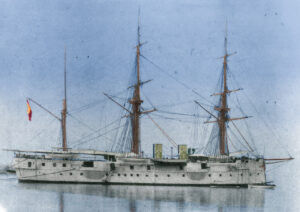 The Aragon class were three unprotected wooden-built cruisers between 1869 and 1882 for the Spanish Navy and named after historical kingdoms or regions of Spain as they were initially designed as central battery ironclads but modified after constrtuction started, as unprotected masted cruisers, and later completely rearmed. Construction time thus was very long, and in 1886 they were considered obsolete. Castilla was sunk at the Battle of Cavite (Manilla) in 1898, Aragón was in the Cadiz Naval Group during the war, later decommissioned and a floating hulk in 1896, scrap in c1905, and Navarra became a training ship in 1899, discarded 1905. #war1898 #navarra #castilla #aragon #armada #spanishnavy #spanamwar #battlemanilla #battlecavite #1898war
The Aragon class were three unprotected wooden-built cruisers between 1869 and 1882 for the Spanish Navy and named after historical kingdoms or regions of Spain as they were initially designed as central battery ironclads but modified after constrtuction started, as unprotected masted cruisers, and later completely rearmed. Construction time thus was very long, and in 1886 they were considered obsolete. Castilla was sunk at the Battle of Cavite (Manilla) in 1898, Aragón was in the Cadiz Naval Group during the war, later decommissioned and a floating hulk in 1896, scrap in c1905, and Navarra became a training ship in 1899, discarded 1905. #war1898 #navarra #castilla #aragon #armada #spanishnavy #spanamwar #battlemanilla #battlecavite #1898war
Development
In 1879, the Armada was mostly made of ageing sailing mixed frigates and nine elderly ironclads and smaller armoured ships, the last dating back from 1870. The last of these corvettes and frigates was launched in 1869, but the Armada concerning its colonial Empire needed more serious assets for its protection. Thus in 1869 it was decided to convert three small ironclads designed in 1868 as station cruisers. Armament and range were the priority, not speed.
Construction of the Aragon-class cruisers started as armored corvettes and central battery ironclads in 1869. Plans were to buff them with 890 tons of armor, including and armoured belt 500 millimetres (19.7 in) thick at the waterline, but budget and resources were lacking and at the time priority was to better protecte Spain’s colonial Empire. So in 1870, it was decided to revise their design and made them unprotected cruisers. Political events however further delayed construction. They were launched much later, between 1879 and 1881, completed in 1880 and 1882. Their basis was that of a wooden hull, totally obsolescent when launched, and the long time the wood stayed in slip was not improving their hull quality overall. At least they received full copper plating and iron reinforcements, but they were not of mixed construction by a long stretch.
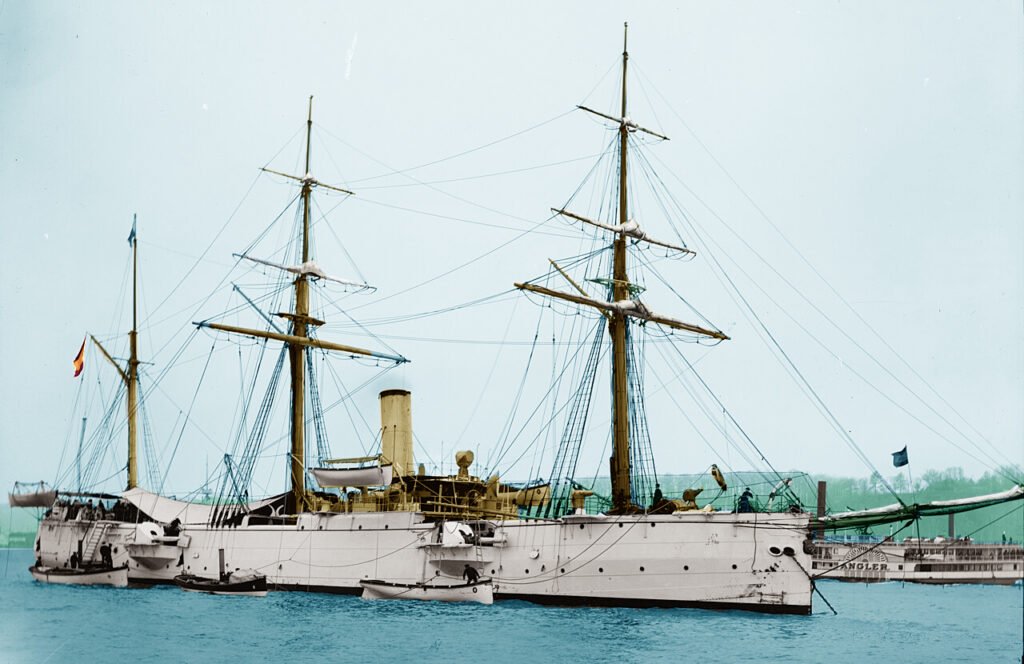
Infanta Santa Isabel, one of the eight unprotected cruisers of the Velaco class built in Spain about the same time. Much smaller, they were also much better suited as cruisers.
They had two funnels and a barque rigging, with three stages for the fore and mainmast, and a composite stud sail for the aft mast. The machinery was originally manufactured at John Penn Co. United Kingdom, for Aragon and at Ferrol under John Penn’s pattern for the two others. The original main battery composed of many broadside Armstrong Whitworth 8-inch (203 mm) guns was seen as obsolescent, so more modern guns were adopted and mounted in sponsons instead, Aragon being the most heavily armed. All three stayed in colonial service and Castilla fought ships at the Battle of Manila Bay that she never was designed to face. Compounded with poor training, improper coal and even shortages of ammunitions, the end result was not surprising.
Aragón was ordered to the Arsenal de Cartagena in 1869, she was launched on 1879 and completed on 1881.
Navarra was ordered to the Arsenal del Ferrol in 1869, launched 1881 and completed in 1889. She became a training ship in 1899, discarded 1905
Castilla was ordered at the Arsenal de Cartagena in 1869, launched in 1881 and completed in 1886, sunk 1/5/1898 at the Battle of Cavite.
Design of the class
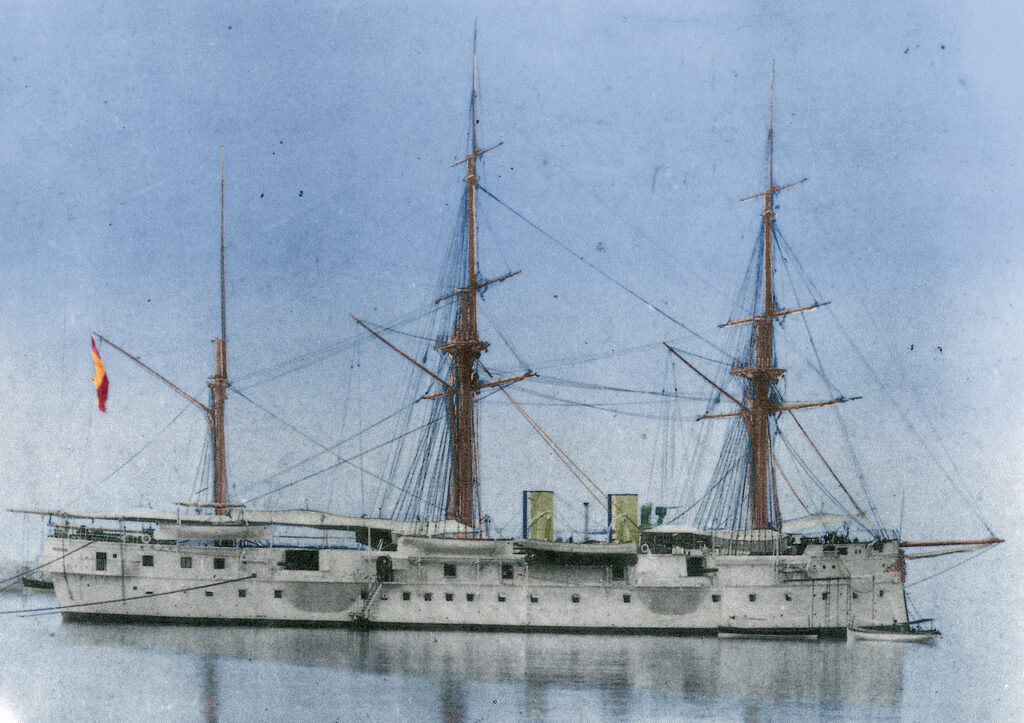
Aragon, colorized by the author
Ships of this class were originally designed as iron-framed but wooden-hulled armored corvettes, central battery. These were even originally ironclads for colonial service and their construction thus started as armored corvettes in 1869, but political unrest in the country delayed construction so much that before planned completion in 1876, they were completely redesigned as unprotected cruisers, their armour never installed and the armament changed completely. Propulsion was modified to achieve greater speed than original 12 knot, armament was completely modernized with a partial armor, until armour was not fitted at all anywhere in a further revision, even masks for the main artillery, now more exposed on decks, notably due to stability concerns. In short the design was changed to an unprotected cruiser or wooden corvette. They were eventually launched that way between 1879 and 1881, completed in 1880 and 1882.
Construction between three different shipyards saw them varied by dimensions and armament, but also under different contracts, origins changed for all.
Hull and general design

The Aragon class ships were on average rated for 3,289 tons standard (Aragon was), with their full tonnage not known, nor her sisters. Conways described how they had been “clumsily built” having been designed as ironclads, with iron framing but wooden all around; Thezy were too large as cruisers, with an unfavourabe hull ratio, being 236 ft (72 m) long for 44 ft (13 m) in beam (so 5.5 ratio) and with a draft of 23 ft 6 in (7.16 m) maximum, not suited for many ports, and already for Cavite where she was anchored. This caused a lot of drag and did not helped with speed. Castilla in 1898 had not been drydock since so much time her hull was covered with barnacles this was even worse, that why she was kept anchored before the battle commenced. At barely 10 knots with her worn out engine and poor coal she would have been a stitting duck.
Powerplant
It was the same for all three, one built in Britain, the two others in Spain at Ferrol under licence: There was one single shaft as customary for ironclads, not liftable, but with a 3-cylinder  horizontal compound, 4,400 ihp (1,100 kW) steam engine, which procured a top speed as contracted of 15 knots (26 km/h), but 14 on trials. By the 1890s it was probably below 12 knots or less.
horizontal compound, 4,400 ihp (1,100 kW) steam engine, which procured a top speed as contracted of 15 knots (26 km/h), but 14 on trials. By the 1890s it was probably below 12 knots or less.
Range was unlimited due to the barque rigging, with fore and main masts having a three tiered square arrangement and the aft mast a spanker and mainsail above, three jibs on bowsprit. They also had intermediate staysails and optional studding sail to catch any wind. Top speed under sail was probably under 10 knots due to her ram bow and large draught. Steam range is unknown, perhaps 900 nm at 10 kt based on 460 tonnes of coal. Due to the location of the four squared boilers, they were truncated in two spaced funnels.
Armament
Initially planned with eight 203mm 15 calibers 180 pounder, 9 tonnes Armstrong RML guns. They were four per broadside concentrated amidship in the armoured citadel that was never made.
-Aragon as completed had six 6.4 in (163 mm) guns all sponsoned under bulwarks, two 3 in (87 mm) guns, four 3 in (75 mm) guns and two 14 in (356 mm) torpedo tubes.
-Navarra as completed had four 5.9 in (150 mm) breech-loading guns, two 4.7 in (119 mm) breech-loading guns, two 87 mm guns and four 75 mm guns and the same TTs.
-Castilla also had the same but ten Maxim machine guns (presumably) were added.
Main: 6.4-in/5.9-in
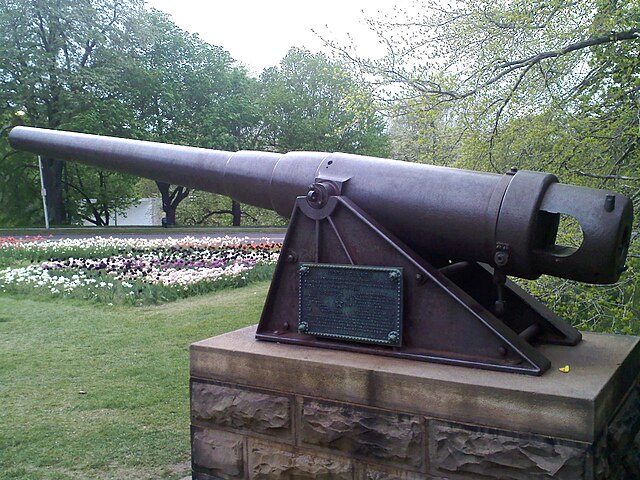
Gonzalez Hontoria de 16 cm mod 1883 BLs:
Smoothbore guns, 6.4 t (7.1 short tons) for 5.8 m (19 ft) long, Barrel length 5.6 m (18 ft 4 in) 35 caliber, 4 m (13 ft 1 in) tall.
Fired a separate loading 29 kg (64 lb) smokeless powder bagged charge and 51–59 kg (112–130 lb) projectile 160 mm (6.3 in)
It used Interrupted screw breech (2 rpm) for a muzzle velocity of 618 m/s (2,030 ft/s), range 9.8 km (6.1 mi) at +17.5°
Krupp 15 cm SK L/35 BLs: designed 1880, produced 1883, 5.8 t (6.4 short tons), 149.1 mm (5.87 in) 35 caliber, 5.25 m (17 ft 3 in) long, useing an Horizontal sliding breech block for 4-5 rpm. Fired a separate loading cased charge and projectile 45.6 kg (101 lb) at 650 m/s (2,100 ft/s)
Elevation -7° to +20°, range 10 km (6.2 mi) at +19°
Remainder:
-Krupp 4.7 in (120 mm) breech-loading guns M1883
-Krupp 87 mm/22 guns M1876
-Krupp 75 mm/24 guns M1883
-Whitehead 14 in (356 mm) torpedo tubes on both beams.
Infanta Isabel was refitted and modernized as training ship, see the detail below.

Author’s old illustration
⚙ specifications |
|
| Displacement | 1,152 tons |
| Dimensions | 210 x 32 x 13 ft 8 in (64 x 9.8 x 4.17 m) |
| Propulsion | & barque-rigged |
| Speed | 13 knots (24 km/h) |
| Range | 200 to 220 tons of coal |
| Armament (Velasco class) | 2× 6-in, 2× 3-in, 2 MG, 2× 14-in TTs |
| Armament* | 4× 4.7 in, 4× 6-pdr, 1 MG, 2× 14-in TTs |
| Protection | None |
| Crew | 173* |
*Infanta Isabel 1921: 1× 66 mm, 10× 6-pdr, crew 194.
 Aragon
Aragon
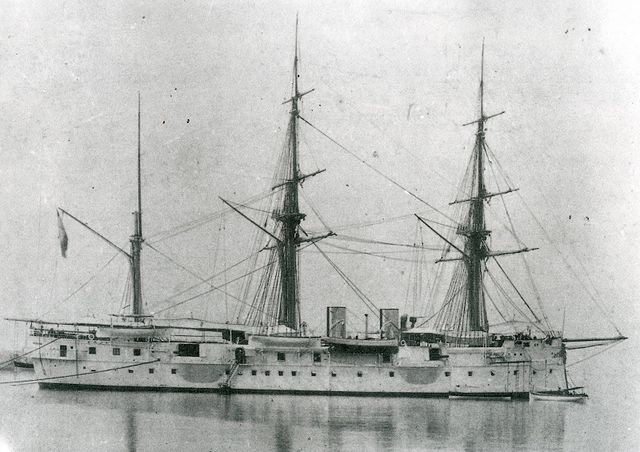
Aragon in in 1897
In 1882, Aragón was assigned to the Philippines and took part in fleet training at Rio Grande de Mindanao with the schooners Sirena and Valiente, transport San Quintín and gunboats Samar, Paragua, Bulusan, Pampanga and Panay. In the 1890s, she was back at home at the Cádiz Naval Group as tensions grew with the USA. She was stationed there mostly like her sister Navarra, as marine depot ship in the arsenal. In 1899, after the war was lost, it was decide dto have her decommissioned, disarmed, and sold for scrap. One of her commanders was Admiral Patricio Montojo y Pasarón, famous for his heroic stance at the Battle of Cavite in 1898, Spanish-American War.
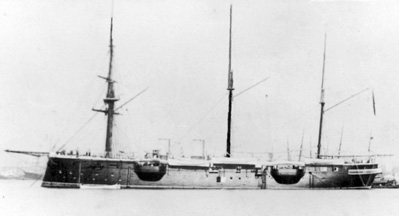 Navarra was completed at the Ferrol naval shipyard in 1882 and was immediately intended for colonial postings. She perhaps had the best artillery of all sisters, not in size but in accuracy and rate of fire. By October 1887 she visited the port of Tangier with her sister Castilla during a Mediterranean cruise. On February 10, 1888, she was in the Bay for a state ceremony. On February 12, she sailed from Tangier with the embassy of the Sultan of Morocco o, board bound for Rome, arriving in Naples on February 17,3 remaining until March 10, until the Moroccan delegates embarked again, mission completed. Due to a storm, she had damaged and needed repairs in Cartagena, before getting bacl to Tangier on March 19, 1887.
Navarra was completed at the Ferrol naval shipyard in 1882 and was immediately intended for colonial postings. She perhaps had the best artillery of all sisters, not in size but in accuracy and rate of fire. By October 1887 she visited the port of Tangier with her sister Castilla during a Mediterranean cruise. On February 10, 1888, she was in the Bay for a state ceremony. On February 12, she sailed from Tangier with the embassy of the Sultan of Morocco o, board bound for Rome, arriving in Naples on February 17,3 remaining until March 10, until the Moroccan delegates embarked again, mission completed. Due to a storm, she had damaged and needed repairs in Cartagena, before getting bacl to Tangier on March 19, 1887.
For the the Universal Exhibition in Barcelona on May 20, 1888, the bulk of the Spanish fleet met in port for a parade. This included the Numancia, screw frigates Gerona and Blanca, cruisers Castilla y Navarra, Isla of Luzon and the Island of Cuba, Destroyer Terror, gunboats Pilar and Cóndor, transport Legazpi. From 1892 Navarra was assigned to the Cuban stations, but returning years later to the peninsula, not long before the war with the US. She was assigned as seafarer school in Cádiz. She was then used as depot ship, partially disarmed, and finally decommissioned, sold for scrap in 1899.
 Castilla
Castilla
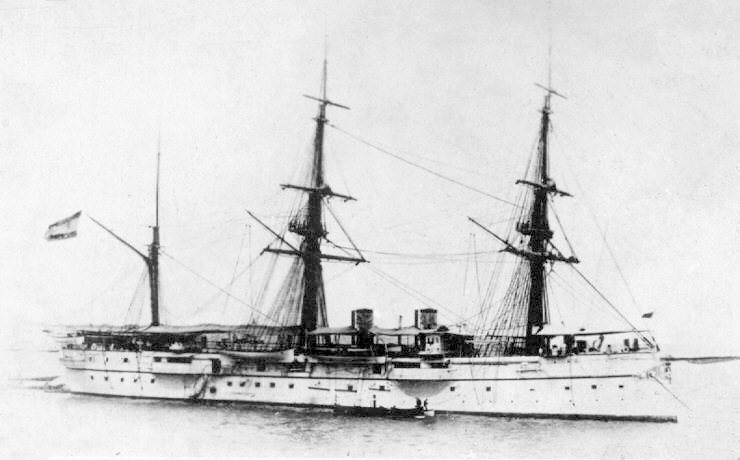
Castilla was commissioned in 1886 as 1st class cruiser, and by August assigned to the Training Squadron. On October 24, 1886 she sailed with other ships intended to make a stance in the Caroline Islands crisis with Germany. By mid-January 1887, the Training Squadron (Rear Admiral José Maymo y Roig) was ordered to the Mediterranean, with port visits along, together with the Numancia as flagship and her sister Castilla amopng others. She was under command of captain José Pérez y Lazaga. On January 24 they stopped at Genoa, then headed on February 2 for La Spezia but their Sicily tour was suspended due to a cholera outbreak in Catania. Instead they headed for Algiers.
On August 25, 1887 she embarked Queen María Cristina in San Sebastián with Navy minister Rodríguez Arias, and the Pdt of the council of minister Sagasta, for a review and trials of early Spanish destroyer Terror and torpedo boats. She sailed with Navarra, to escorted the Royal steamer Ferrolano on September 4, 1887 for a visit to Guetaria and back to San Sebastian.
By October 1887 she visite Tangier with Navarra and on February 10, 1888 returned in the Bay of Tangier under Captain Lazaga for the Moroccan embassy trip to Rome. Like her sister she was present at the opening of the Universal Exhibition in Barcelona on May 20, 1888.
From July to September 1888, she toured France, Italy, Austria and Greece with the Training Squadron. In Toulon on September 9 she attended the delivery of battleship Pelayo with the Training Squadron under Rear Admiral Don José de Carranza y Echevarría.
On January 10, 1889 she sailed from Mahón to Puente Mayorga with the screw frigate Nuestra Señora del Carmen, damaged so she had the frigate in tow on January 14, arriving in the bay of Cádiz on the morning of January, 15.
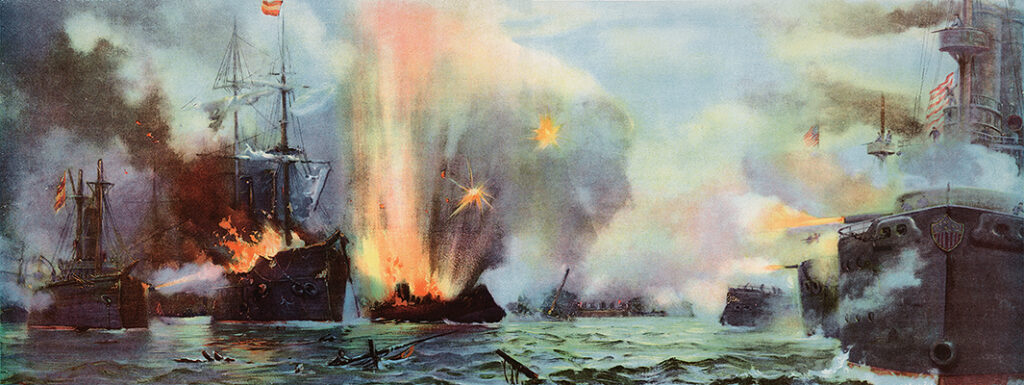
Representation of the Battle of Cavite by JG Tyler.
On March 23, 1889 she sailed to Tangier to take the new Spanish representative to the Sultan of Morocco Francisco Rafael Figueras back home for a reunion. In September 1889 Moroccan insurgents attacked the gunboat Cocodrilo. On September 23 she was sent to show force at Alhucemas with the Instruction Squadron anchored in Cádiz (Rear Admiral Carranza), incldung the brand new battleship Pelayo still without its artillery, Numancia and her sister Castilla, meeting there the frigate Gerona, cruiser Isla de Luzon. Navarra later sailed towards Al Hoceima with emissaries from the Sultan to free VIP prisoners, Miguel and Teresa.
At the beginning of 1890 she was assigned to the Philippine Stations, sailing with the cruisers Don Antonio de Ulloa and Don Juan de Austria. On April 9, 1890, all three sail from Barcelona under command of Captain Manuel de la Cámara y Livermore, arriving in Manila on June 17. Due to their hulls they were nicknamed the “black squadron” since all colonial ships were usually white.
In June 1893, she visited Yokohama. In 1895 a treaty was signed with Japan to establish territorial Pacific limits of expansion.
In August 1896 she took part in several army operations against insurgents in and around Cavite. As war broke out with the US she was stationed at the Cavite station under command of Captain Alonso Morgado y Pita da Veiga. On May 1, 1898, Battle of Cavite, her machinery was downright useless and she was towed in a favourable gun position. All her artillery from the opposite side was disembarked to reinforce coastal defenses. She did not survived the initial pass of Commodore George Dewey’s American squadron. Blasted away, she burned heavily and was abandoned, destroyed completely, sinking after the second pass in shallow waters and having 25 dead and 30 wounded.
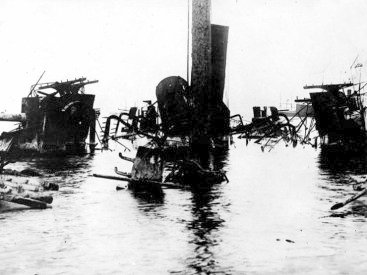
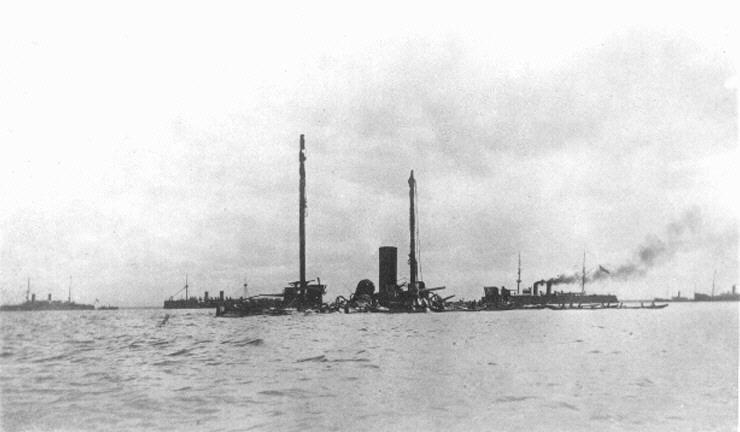
Castilla’s wreck after the battle of Cavite
Read More/Src
Books
Conway’s All the World’s Fighting Ships 1860–1905, p. 383
Chesneau, Roger, and Eugene M. Kolesnik, Eds. Conway’s All The World’s Fighting Ships 1860–1905.
Nofi, Albert A. The Spanish–American War, 1898. Conshohocken, Pennsylvania: Combined Books.
Bordejé y Morencos, Fernando de (1995). Crónica de la Marina española en el siglo XIX, 1868-1898. Tomo II.
Coello Lillo, Juan Luis; Agustín Ramón Rodríguez González (2001). Buques de la Armada Española a través de la Fotografía.
Lledó Calabuig, José (1998). buques de vapor de la armada española, del vapor de ruedas a la fragata acorazada, 1834-1885
Fernández Rodríguez, Manuel (1986). España y Marruecos en los primeros años de la Restauración (1875-1894).
Martínez de Velasco, Eusebio «La fragata Carmen conducida a Remolque por el crucero Castilla hasta la bahía de Cádiz». La ilustración Española y Americana (Madrid)
Rivas Fabal, José Enrique (2007). Historia de la Infantería de Marina española. Tomo II. Madrid:
Salgado Alba, Jesús (diciembre de 1976). «El crucero Castilla. Héroe y holocausto en el Cavite». Revista General de Marina
Links
spanamwar.com/spanwoodenbcruisers.htm
spanamwar.com/castilla.htm
battleships-cruisers.co.uk/spanish_cruisers.htm
https://www.gbv.de/dms/sub-hamburg/235095680.pdf
todoavante.es Castilla_(1886)
todoavante.es Navarra_(1881)
todoavante.es Aragon_(1880)
armada.defensa.gob.es/
vidamaritima.com/ crucero aragon patricio javier montojo
web.archive.org/ sp_cr_aragon.htm
history.navy.mil/ wreck-of-castilla.html
en.wikipedia.org/ Aragon-class_cruiser
es.wikipedia.org
en.wikipedia.org Gonzalez_Hontoria_de_16_cm_mod_1883
en.wikipedia.org 15_cm_SK_L/35

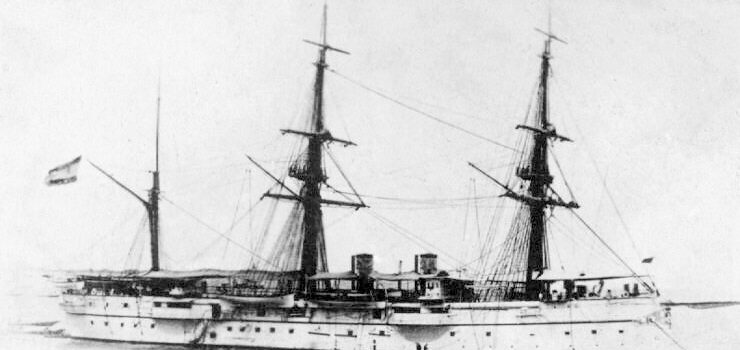

 Latest Facebook Entry -
Latest Facebook Entry -  X(Tweeter) Naval Encyclopedia's deck archive
X(Tweeter) Naval Encyclopedia's deck archive Instagram (@navalencyc)
Instagram (@navalencyc)





 French Navy
French Navy Royal Navy
Royal Navy Russian Navy
Russian Navy Armada Espanola
Armada Espanola Austrian Navy
Austrian Navy K.u.K. Kriegsmarine
K.u.K. Kriegsmarine Dansk Marine
Dansk Marine Nautiko Hellenon
Nautiko Hellenon Koninklije Marine 1870
Koninklije Marine 1870 Marinha do Brasil
Marinha do Brasil Osmanlı Donanması
Osmanlı Donanması Marina Do Peru
Marina Do Peru Marinha do Portugal
Marinha do Portugal Regia Marina 1870
Regia Marina 1870 Nihhon Kaigun 1870
Nihhon Kaigun 1870 Preußische Marine 1870
Preußische Marine 1870 Russkiy Flot 1870
Russkiy Flot 1870 Svenska marinen
Svenska marinen Søværnet
Søværnet Union Navy
Union Navy Confederate Navy
Confederate Navy Armada de Argentina
Armada de Argentina Imperial Chinese Navy
Imperial Chinese Navy Marinha do Portugal
Marinha do Portugal Mexico
Mexico Kaiserliche Marine
Kaiserliche Marine 1898 US Navy
1898 US Navy Sovietskiy Flot
Sovietskiy Flot Royal Canadian Navy
Royal Canadian Navy Royal Australian Navy
Royal Australian Navy RNZN Fleet
RNZN Fleet Chinese Navy 1937
Chinese Navy 1937 Kriegsmarine
Kriegsmarine Chilean Navy
Chilean Navy Danish Navy
Danish Navy Finnish Navy
Finnish Navy Hellenic Navy
Hellenic Navy Polish Navy
Polish Navy Romanian Navy
Romanian Navy Turkish Navy
Turkish Navy Royal Yugoslav Navy
Royal Yugoslav Navy Royal Thai Navy
Royal Thai Navy Minor Navies
Minor Navies Albania
Albania Austria
Austria Belgium
Belgium Columbia
Columbia Costa Rica
Costa Rica Cuba
Cuba Czechoslovakia
Czechoslovakia Dominican Republic
Dominican Republic Haiti
Haiti Hungary
Hungary Honduras
Honduras Estonia
Estonia Iceland
Iceland Eire
Eire Equador
Equador Iran
Iran Iraq
Iraq Latvia
Latvia Liberia
Liberia Lithuania
Lithuania Mandchukuo
Mandchukuo Morocco
Morocco Nicaragua
Nicaragua Persia
Persia San Salvador
San Salvador Sarawak
Sarawak Uruguay
Uruguay Venezuela
Venezuela Zanzibar
Zanzibar Warsaw Pact Navies
Warsaw Pact Navies Bulgaria
Bulgaria Hungary
Hungary

 Bundesmarine
Bundesmarine Dutch Navy
Dutch Navy Hellenic Navy
Hellenic Navy Marina Militare
Marina Militare Yugoslav Navy
Yugoslav Navy Chinese Navy
Chinese Navy Indian Navy
Indian Navy Indonesian Navy
Indonesian Navy JMSDF
JMSDF North Korean Navy
North Korean Navy Pakistani Navy
Pakistani Navy Philippines Navy
Philippines Navy ROKN
ROKN Rep. of Singapore Navy
Rep. of Singapore Navy Taiwanese Navy
Taiwanese Navy IDF Navy
IDF Navy Saudi Navy
Saudi Navy Royal New Zealand Navy
Royal New Zealand Navy Egyptian Navy
Egyptian Navy South African Navy
South African Navy






























 Ukrainian Navy
Ukrainian Navy dbodesign
dbodesign